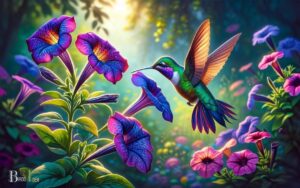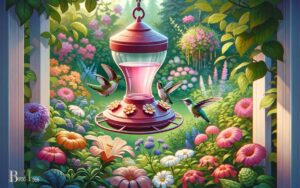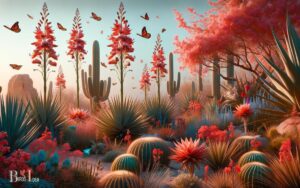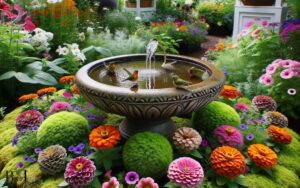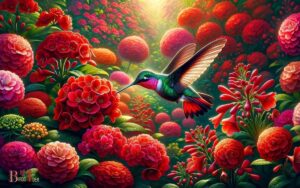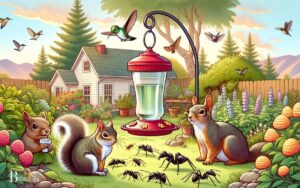Does Carolina Jasmine Attract Hummingbirds? Yes!
Yes, Carolina Jasmine, also known as Gelsemium sempervirens, is known to attract hummingbirds. The vine’s bright yellow, trumpet-shaped flowers provide nectar that is highly appealing to these tiny birds.
Carolina Jasmine, a native to the southeastern United States, is a popular ornamental plant due to its fragrant and vibrant flowers that bloom in the spring.
The plant’s nectar-rich blossoms are particularly enticing to hummingbirds, who are drawn to the tubular flowers that are perfectly shaped for their feeding habits.
The high nectar concentration serves as an important food source for hummingbirds, especially during early spring when other nectar sources might be scarce.
Carolina Jasmine’s alluring flowers not only add aesthetic value to gardens but also play a crucial role in supporting local hummingbird populations by providing essential nectar during migration and breeding seasons.
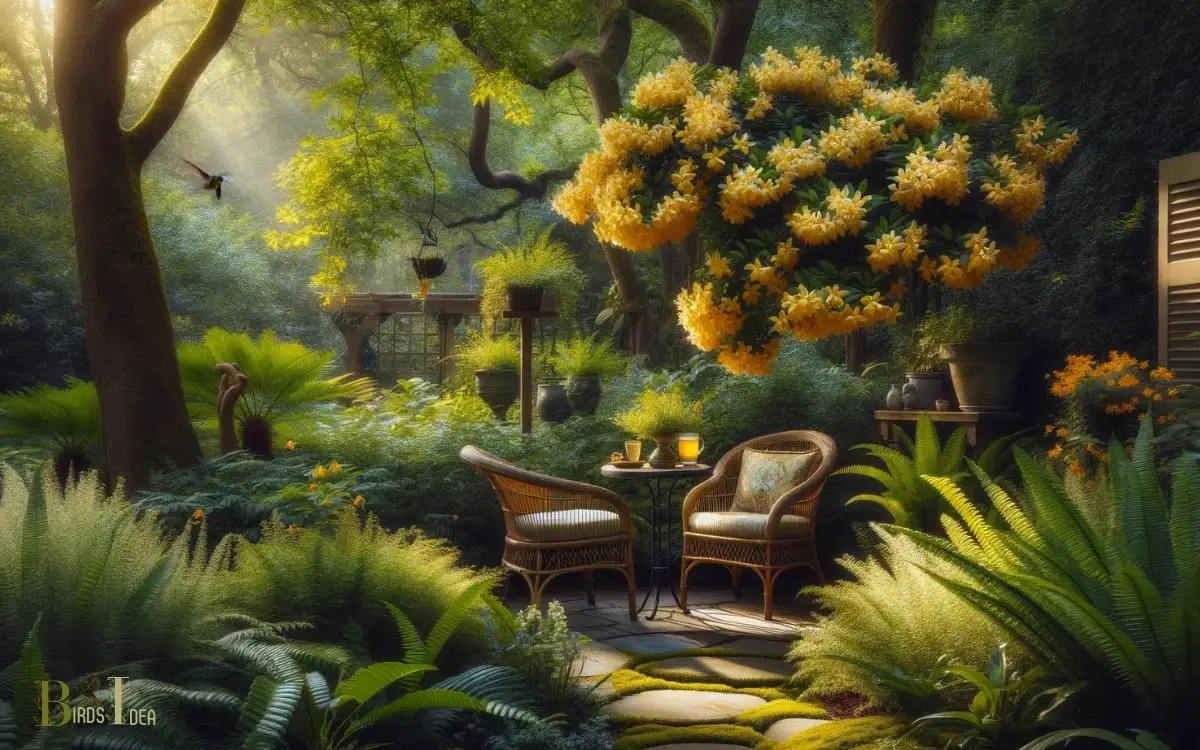
Key Takeaway
The Attraction of Hummingbirds to Flowers
Many flowers have evolved to attract hummingbirds with their nectar, color, and shape. Carolina Jasmine’s sweet fragrance and abundant nectar production make it a favorite of hummingbirds seeking sustenance.
Additionally, the vibrant yellow color of Carolina Jasmine blooms acts as a beacon for hummingbirds, drawing them in for a closer look and a taste of nectar.
Hummingbirds and Flower Nectar
Hummingbirds are instinctively drawn to flowers with high nectar content, which plays a crucial role in their attraction to certain plant species.
The high energy demands of hummingbirds require them to consume large amounts of nectar, making them frequent visitors to nectar-rich flowers.
The shape and size of the flowers also influence the type of hummingbird species they attract.
Tubular-shaped flowers are particularly appealing to hummingbirds, as they are adapted to their long, specialized bills.
Additionally, the nectar’s sugar concentration and the flower’s accessibility are key factors in attracting hummingbirds.
Flowers with high sugar content nectar and easy access provide the necessary energy and efficiency that hummingbirds seek.
As such, the presence of these features in flowers greatly enhances their appeal to hummingbirds.
This nectar-based attraction forms the foundation for the next topic, which explores how flower color also influences hummingbird attraction.
Flower Color Attracts Hummingbirds
Adapted to their long, specialized bills, hummingbirds frequently seek out flowers with high nectar content, but the influence of flower color on their attraction is equally significant. When it comes to attracting hummingbirds, flower color plays a crucial role.
Here are four key points about how flower color attracts hummingbirds:
- Brightly colored flowers, particularly those in shades of red, orange, and pink, are highly attractive to hummingbirds.
- These colors signal a high nectar reward, drawing hummingbirds to the flowers.
- Hummingbirds have excellent color vision, particularly in the red part of the spectrum, making them especially responsive to these hues.
- While color is important, shape and size also contribute to a flower’s appeal to hummingbirds.
Understanding the significance of flower color in attracting hummingbirds provides valuable insight into their foraging behavior and preferences.
The Importance of Fragrance in Attracting Hummingbirds
Attracting hummingbirds relies on having a pleasing fragrance in the surrounding environment.
The importance of fragrance in attracting hummingbirds cannot be overstated, as it plays a crucial role in attracting these tiny, energetic birds.
Here are four crucial reasons why fragrance is essential in attracting hummingbirds:
- Natural Attraction: Hummingbirds are naturally drawn to sweet-smelling nectar, making fragrance a key factor in attracting them to a particular area.
- Foraging Behavior: The pleasant scent of flowers and plants signals to hummingbirds that there may be a potential food source nearby, prompting them to investigate further.
- Navigation Aid: Fragrant flowers and plants can act as beacons, helping hummingbirds navigate their surroundings and locate feeding opportunities.
- Enhanced Pollination: Fragrance not only attracts hummingbirds but also contributes to the pollination of plants, creating a mutually beneficial relationship between the birds and the flora.
The Characteristics of Carolina Jasmine
Carolina Jasmine typically blooms from late spring to early summer, attracting attention with its fragrant, star-shaped flowers.
This evergreen vine, known scientifically as Gelsemium sempervirens, is native to the southeastern United States and is prized for its ornamental value.
Its dark green leaves and yellow blossoms make it a popular choice for arbors, fences, and trellises.
Carolina Jasmine is a low-maintenance plant that thrives in well-drained soil and full sun to partial shade. It is also drought-tolerant once established, making it a resilient choice for gardeners.
While admired for its beauty, it’s important to note that all parts of the Carolina Jasmine plant are toxic if ingested, so caution should be exercised, especially in households with pets or small children.
The Relationship Between Carolina Jasmine and Hummingbirds
Carolina Jasmine and hummingbirds have a unique relationship that draws the birds to the plant. Many gardeners have found success in attracting hummingbirds by planting Carolina Jasmine in their yards.
Understanding the specific qualities of Carolina Jasmine that appeal to hummingbirds can help create a thriving environment for these beautiful creatures.
Hummingbirds and Carolina Jasmine
The Carolina Jasmine’s sweet fragrance and nectar-rich flowers attract hummingbirds to its vicinity.
Hummingbirds and Carolina Jasmine share a mutually beneficial relationship, enhancing the ecosystem and providing visual delight for observers.
Here are four key points about the relationship between hummingbirds and Carolina Jasmine:
- Pollination: Hummingbirds are the primary pollinators of Carolina Jasmine, aiding in its reproduction and contributing to the plant’s proliferation.
- Nectar Source: Carolina Jasmine serves as a vital nectar source for hummingbirds, providing them with the energy they need for their rapid metabolism.
- Migration Stopover: The blooming period of Carolina Jasmine coincides with the migration of hummingbirds, offering them a crucial refueling stop during their journey.
- Visual Attraction: The vibrant, trumpet-shaped flowers of Carolina Jasmine attract hummingbirds with their vivid colors and distinct shape, making them easily noticeable to these avian pollinators.
Attracting Hummingbirds With Jasmine
Jasmine blooms during the hummingbird migration season, attracting the birds with its nectar-rich flowers and vibrant colors.
Hummingbirds are drawn to the sweet, aromatic nectar, making jasmine a delightful addition to any garden looking to attract these beautiful creatures.
Here’s a comparison of jasmine varieties commonly known to attract hummingbirds:
| Jasmine Variety | Flower Color | Fragrance Level |
|---|---|---|
| Carolina Jasmine | Yellow | Strong |
| Confederate Jasmine | White | Moderate |
| Arabian Jasmine | White | Strong |
The table above illustrates the different jasmine varieties and their respective flower colors and fragrance levels, offering gardening enthusiasts a helpful guide in selecting the right jasmine to entice hummingbirds.
The Blooming Season of Carolina Jasmine
During its blooming season, Carolina jasmine attracts a variety of pollinators to its fragrant flowers.
The blooming season for Carolina jasmine typically occurs in late winter to early spring, although it can vary depending on the specific climate and growing conditions.
In warmer regions, the blooming season may begin as early as February and last through April, while in cooler climates, it may start in March and extend into May.
This deciduous vine produces an abundance of bright yellow, star-shaped flowers that emit a sweet, intoxicating fragrance, making it a popular choice for gardens and landscapes.
The blooming season is a crucial time for pollinators, including bees and butterflies, to visit the flowers and aid in the process of fertilization.
The Geographic Considerations for Hummingbird Attraction
The geographic location of a garden or landscape plays a significant role in attracting hummingbirds to Carolina jasmine.
When considering the geographic elements for hummingbird attraction, it’s essential to keep the following in mind:
- Climate: Hummingbirds are prevalent in regions with mild temperatures and abundant nectar sources.
- Migration Patterns: Understanding the migration routes of hummingbirds can help predict their presence in specific areas.
- Native Flora: Hummingbirds are attracted to native plants, so incorporating Carolina jasmine into a garden in its natural range can enhance its appeal.
- Elevation: Different species of hummingbirds thrive at varying elevations, so the garden’s altitude can influence their presence.
Considering these geographic factors can greatly enhance the likelihood of attracting hummingbirds to Carolina jasmine.
Understanding how these elements interact with the plant’s environment is crucial for successful hummingbird attraction.
The Care and Maintenance of Carolina Jasmine
Owners should regularly prune Carolina jasmine to maintain its health and promote optimal growth.
Proper care and maintenance are essential for ensuring this beautiful vine thrives in the garden.
Here are some important care tips for Carolina jasmine:
| Care Tips | Description |
|---|---|
| Watering | Ensure the soil is consistently moist but well-drained. Overwatering can lead to root rot. |
| Fertilization | Apply a balanced fertilizer in the spring to encourage healthy foliage and abundant blooms. |
| Sunlight | Plant Carolina jasmine in full sun to partial shade for the best flowering and growth performance. |
The Potential for Carolina Jasmine in Hummingbird Gardens
Carolina jasmine is an attractive option for hummingbird gardens due to its vibrant blooms and potential to attract these delightful birds.
When considering Carolina jasmine for a hummingbird garden, it’s important to take into account the following:
- Flower Characteristics: The tubular, bright yellow flowers of Carolina jasmine are particularly appealing to hummingbirds, making it a desirable addition to any hummingbird garden.
- Blooming Period: Carolina jasmine blooms in late winter and early spring, providing a crucial food source for hummingbirds during their migration and breeding seasons.
- Low Maintenance: This plant is relatively low maintenance, making it an easy and sustainable choice for hummingbird gardens.
- Versatile Growing Conditions: Carolina jasmine can thrive in various soil types and light conditions, making it adaptable to different garden environments.
Conclusion
Carolina Jasmine does attract hummingbirds due to its bright, fragrant flowers and the timing of its blooming season.
So, if you’re looking to attract these delightful little birds to your garden, consider adding Carolina Jasmine to your landscape.
With its beautiful blooms and the potential for creating a hummingbird haven, it’s a win-win for both you and these charming creatures.

